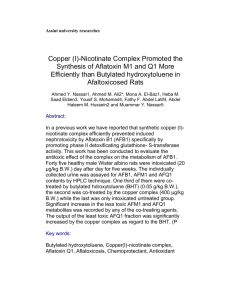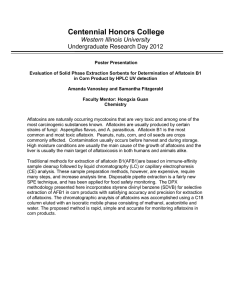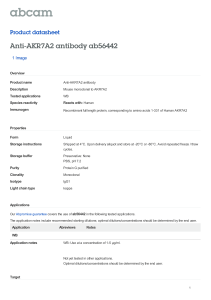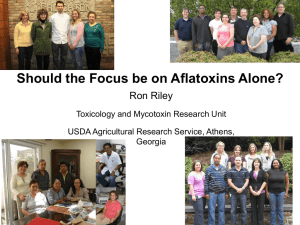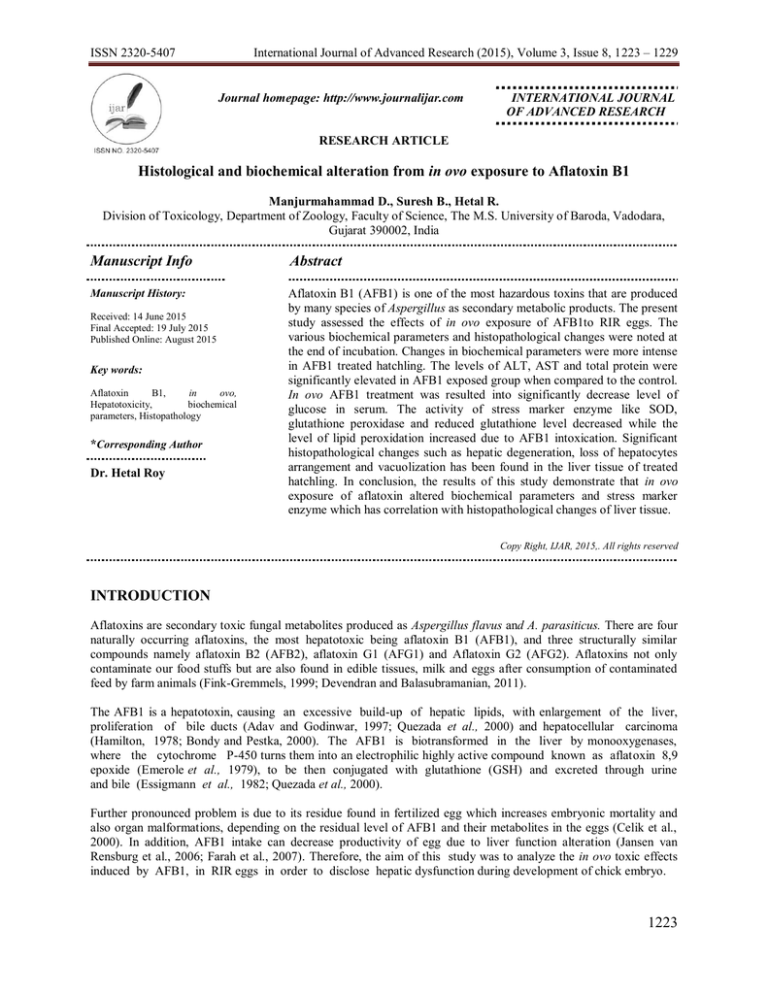
International Journal of Advanced Research (2015), Volume 3, Issue 8, 1223 – 1229
ISSN 2320-5407
Journal homepage: http://www.journalijar.com
INTERNATIONAL JOURNAL
OF ADVANCED RESEARCH
RESEARCH ARTICLE
Histological and biochemical alteration from in ovo exposure to Aflatoxin B1
Manjurmahammad D., Suresh B., Hetal R.
Division of Toxicology, Department of Zoology, Faculty of Science, The M.S. University of Baroda, Vadodara,
Gujarat 390002, India
Manuscript Info
Abstract
Manuscript History:
Aflatoxin B1 (AFB1) is one of the most hazardous toxins that are produced
by many species of Aspergillus as secondary metabolic products. The present
study assessed the effects of in ovo exposure of AFB1to RIR eggs. The
various biochemical parameters and histopathological changes were noted at
the end of incubation. Changes in biochemical parameters were more intense
in AFB1 treated hatchling. The levels of ALT, AST and total protein were
significantly elevated in AFB1 exposed group when compared to the control.
In ovo AFB1 treatment was resulted into significantly decrease level of
glucose in serum. The activity of stress marker enzyme like SOD,
glutathione peroxidase and reduced glutathione level decreased while the
level of lipid peroxidation increased due to AFB1 intoxication. Significant
histopathological changes such as hepatic degeneration, loss of hepatocytes
arrangement and vacuolization has been found in the liver tissue of treated
hatchling. In conclusion, the results of this study demonstrate that in ovo
exposure of aflatoxin altered biochemical parameters and stress marker
enzyme which has correlation with histopathological changes of liver tissue.
Received: 14 June 2015
Final Accepted: 19 July 2015
Published Online: August 2015
Key words:
Aflatoxin
B1,
in
ovo,
Hepatotoxicity,
biochemical
parameters, Histopathology
*Corresponding Author
Dr. Hetal Roy
Copy Right, IJAR, 2015,. All rights reserved
INTRODUCTION
Aflatoxins are secondary toxic fungal metabolites produced as Aspergillus flavus and A. parasiticus. There are four
naturally occurring aflatoxins, the most hepatotoxic being aflatoxin B1 (AFB1), and three structurally similar
compounds namely aflatoxin B2 (AFB2), aflatoxin G1 (AFG1) and Aflatoxin G2 (AFG2). Aflatoxins not only
contaminate our food stuffs but are also found in edible tissues, milk and eggs after consumption of contaminated
feed by farm animals (Fink-Gremmels, 1999; Devendran and Balasubramanian, 2011).
The AFB1 is a hepatotoxin, causing an excessive build-up of hepatic lipids, with enlargement of the liver,
proliferation of bile ducts (Adav and Godinwar, 1997; Quezada et al., 2000) and hepatocellular carcinoma
(Hamilton, 1978; Bondy and Pestka, 2000). The AFB1 is biotransformed in the liver by monooxygenases,
where the cytochrome P-450 turns them into an electrophilic highly active compound known as aflatoxin 8,9
epoxide (Emerole et al., 1979), to be then conjugated with glutathione (GSH) and excreted through urine
and bile (Essigmann et al., 1982; Quezada et al., 2000).
Further pronounced problem is due to its residue found in fertilized egg which increases embryonic mortality and
also organ malformations, depending on the residual level of AFB1 and their metabolites in the eggs (Celik et al.,
2000). In addition, AFB1 intake can decrease productivity of egg due to liver function alteration (Jansen van
Rensburg et al., 2006; Farah et al., 2007). Therefore, the aim of this study was to analyze the in ovo toxic effects
induced by AFB1, in RIR eggs in order to disclose hepatic dysfunction during development of chick embryo.
1223
ISSN 2320-5407
International Journal of Advanced Research (2015), Volume 3, Issue 8, 1223 – 1229
Material and Methods
Experimental Protocol
Fertile Rhode Island Red (RIR) eggs were obtained from the department of livestock production & management,
Anand Agricultural University, Anand. All eggs were wiped with 70% ethanol and numbered. Eggs were grouped in
three (control, vehicle control and treated), 25 in each. Protocol was approved by departmental ethical committee
according to CPCSEA. The concentrations of 5ng/5μl 20%alcohol/egg of AFB1 in treatment group and 5μl
20%alcohol/egg of alcohol were injected in vehicle control group in air sac of eggs with sterile syringe at ‘0’ day of
incubation. The eggs were placed into an incubator at 37.5 0C, 65% relative humidity and turned every 3 hours.
Weight mobility of incubated eggs was followed every day, and the mortality estimated by candling of eggs. After
21 days of incubation, hatchlings were sacrificed after collecting blood through heart puncture and gross anatomical
change of liver was observed. Liver was removed, washed in PBS then blotted and weighted. From a pair of kidney
one was fixed in 10% formalin for histopathology and second was used to estimate biochemical parameters.
Biochemical Parameters
Blood samples were centrifuged and serum was separated. Liver tissue was homogenized in PBS, centrifuged and
supernatant was separated for biochemical assay. Alanine transaminase (ALT) and aspartate transaminase (AST)
level was estimated by the IFCC (International federation of clinical chemistry) (Bergmeyer et al., 1978) method
using Reckon diagnostic kit. Protein concentration in serum was determined by the Lowry method (1951) and
Glucose was estimated by GOD/POD method (Glucose oxidase/Peroxidase) as described by Trinder (1969).
Oxidative stress marker parameters
MDA was determined by the method of Buege and Aust (1978) based on the principle of thiobarbituric acid (TBA)
reacts with MDA and forms red color. The activity of superoxide dismutase (SOD) was assessed by method
described by Marklund and Marklund (1974).GSH level was assessed according to the method of Beutler et al.
(1963). GPx was determined spectrophotometrically according to the method of Rotruck et al. (1973).
Histopathological examination
Liver was removed, washed in saline, and fixed in 10% buffered formalin for histopathological examinations. The
liver sections were stained with Hematoxylin and Eosin (H & E) stains (Luna 1968). The H & E stained slides were
observed under the microscope (Leica DM2500).
Statistical analysis
Data generated from the experiment were subjected to statistical analysis and presented as mean and standard error
around mean. The statistical significance of the differences between the mean values of control and experimental
groups was evaluated through one-way analysis of variance (ANOVA) followed by Bonferroni’s post-hoc test.
Statistical analysis performed using GraphPad prism (version 6) software.
Result
In the present study, the AFB1 administered egg showed greater mortality compare to that of control. AFB1
intoxication resulted into decrease body weight and increased relative weight of liver in hatchling. Mean body
weight obtained at the end of the incubation was significantly reduced whereas relative weight of liver was not
observed significantly increased in newly hatched chick of treatment group as compared with the control group
(Table -1).
The effects of AFB1 on certain blood biochemical parameters are summarized in table 2. In ovo exposed hatchling
exhibited a significant increase in the activity of ALT by 86.14% over those values obtained from the control group.
AFB1 intoxication also resulted in a significant increase in the activity of AST and total protein by 48.03 and
39.21%, respectively, compared to the values obtained from the untreated group. There was no observed change in
vehicle control group compare to control. Serum glucose level showed a significant decrease (P<0.001) in hatchling
that underwent in ovo treatment of 5ng AFB1/egg.
The level of malondialdehyde (MDA) increased significantly in 5ng AFB1 treated group as compare to control
(P<0.001). SOD activity was decreased significantly due to in ovo AFB1 exposure (P<0.01, Table-3). As with SOD,
the GPx and GSH level were significantly decreased in the liver extracts of the treated hatchling as compared with
the control (P<0.05 and P<0.001, respectively).
Microscopic observation of histological architecture of liver showed normal structure of the central vein, radially
arranged hepatocytes around the central vein (Fig. 1A, B). In contrast to the normal histological examination of the
1224
ISSN 2320-5407
International Journal of Advanced Research (2015), Volume 3, Issue 8, 1223 – 1229
liver tissue of the controls, marked degenerative changes of hepatocytes, congestion, and marked diffuse necrosis of
hepatic tissue were observed in liver of AFB1treated hatchling (Fig. 1).Vacuolar degeneration and gross
hepatocellular damage were observed damage of treated tissue. Sinusoid dilation was also observed in AFB1 treated
liver.
Table: 1 Effects of AFB1 on body weight and relative weight of liver of hatchling
Groups
Body weight of Embryo
Relative Weight of Liver
(gm/chick)
(mg/100gm body weight)
122±15.8
125 ±16.1
85 ±20.5↓*
Control
VC
Treated
4.6 ± 0.2
4.8 ± 0.6
5.9 ± 0.9↑**
@
Values are expressed as Mean ± SE; n=10 for each group; * p ≤ 0.05; ** p ≤ 0.01
Table: 2 Serum biochemical profile of in ovo AFB1 intoxicated hatchling
Groups
ALT
AST
(IU/L)
(IU/L)
Protein
(mg/dL)
47.1±0.9
30.1± 2.1
49.7±0.4
32.4± 1.9
41.9±
1.5↑**
69.8±0.06↑***
@
Values are expressed as Mean ± SE; n=10 for each group; ** p ≤ 0.01; *** p ≤ 0.001
Control
VC
Treated
22.2±0.06
23.3±0.4
41.4±0.9↑***
Glucose
(mg/dl))
324.2±9.5
309.3±11.2
214.8±3.066↓***
Table: 3 Oxidative stress markers in liver of chicks hatched from eggs inoculated with AFB1
Groups
LPO
SOD
GSH
GPx
(nM of MDA released /gm (%
inhibition (µg/gm of tissue) mM of GSH consumed/
of tissue)
/min/mg tissue)
mg tissue
Control
7.3± 0.43
13.7 ± 0.4
2.2± 0.07
21.3± 0.4
VC
7.6± 0.9
12.3 ± 0.4
1.9 ± 0.09
20.6 ± 0.4
24.4± 1.40↑***
10.5 ± 0.2↓**
0.7± 0.02↓***
17.5 ± 0.07↓*
Treated
@
Values are expressed as Mean ± SE; n=10 for each group; * p ≤ 0.05; ** p ≤ 0.01; *** p ≤ 0.001
Figure 1. Histological profile of liver from a day-old hatchling intoxicated by AFB1 at ‘0’day of
incubation.
1225
ISSN 2320-5407
International Journal of Advanced Research (2015), Volume 3, Issue 8, 1223 – 1229
(A) Control showing normal histological profile, 10X; (B) Control section showing Central Vein (CV),
20X; (C, D) Vehicle treated with mild sinusoid dilation; (E) Low dose showing damaged
histoarchitecture and dilated sinusoid; (F) High dose showing Centrilobular destruction (black arrow)
with gross hepatocellular damage (red arrow).
Discussion
AFB1 is able to cross the maternal placental barrier to reach the fetus and offers a potential threat to animal and
human health in view of their teratogenicity (Wangikar et al., 2005, Ozaydın and Sur 2015). In poultry, the AFB1
carry over from food to the fertilized egg leads to serious economic loss by decreasing embryo viability and
hatchability (Sur et al., 2011) and by causing organ malformations (Cilievici et al., 1980; Ozaydın and Sur 2015).
Increased mortality was observed in current study which is also observed by Cravens et al. (2013) after AFB1
exposure in broiler egg. Body weight of newly hatched chickens was depressed by in ovo AFB1 injection in current
study. Similar results of weight reduction due to aflatoxicosis have been reported by Quezada et al. (2000), Magnoli
et al. (2011) and Oznurlu et al., (2012). The decrease in body weight may be due to the oxidative stress and
hepatotoxicity of AFB1,while the increase in relative liver weight could be attributed to the relationship between the
liver weight increase and various toxicological effects or to the reduction in body weight gain of experimental
animals (Mansour and Mossa, 2010; Mossa et al., 2015).
1226
ISSN 2320-5407
International Journal of Advanced Research (2015), Volume 3, Issue 8, 1223 – 1229
Combinations of some common biochemical parameters provide better information from pattern recognition, e.g.
enzymes like ALT and AST for hepatotoxicity (Evans 1996; Hany and Gamal, 2013). The results of the present
study showed that in ovo AFB1, inoculation, significantly increased the activity of ALT and AST compared to the
control group. The elevation in the liver enzyme activities may be due to liver dysfunction with a consequent
reduction in enzyme biosynthesis and altered membrane permeability permitting enzyme leakages into the blood
(Mansour and Mossa 2010; Hany and Gamal, 2013) which is also resulted into elevation of total protein in serum,
could be attributed to hepatic detoxification. This is supportive to the result of protein content of current study which
showed significant elevation of serum total protein compare to unexposed eggs of target toxicant. Similar findings
have been described after aflatoxin exposure on liver marker enzymes (Tessari et al., 2010; Hassan et al., 2012; Jha
et al., 2013; Jafari et al 2014).The result revealed that marked decrease in glucose contents of hatchling in response
to aflatoxicosis. The reduction in glucose uptake may be attributed to the decrease in the number of GLUT 1 and
GLUT 4 transporters in response to aflatoxicosis (Kiessling, 1986; Abdulmajeed, 2011).
Results showed that the levels of GPX and SOD were diminished in hatchling exposed by AFB1. On the other
hand, lipid peroxidation was elevated and it is believed to be one of the main markers of ROS-mediated tissue
damage. Significant reduction of hepatic GSH level was also observed as compare to untreated group. This is in
agreement with findings reported previously in liver (Choudhary and Verma 2005; Naaz et al., 2007; El-Nekeety et
al., 2014). Some studies on the mechanisms of mycotoxins induced liver injury have demonstrated that glutathione
and SOD play an important role in the detoxification of the reactive and toxic metabolites of this AFB1, and then the
liver necrosis begins when the glutathione stores are almost exhausted (Abdel-Wahhab et al., 2010). It supports
present findings with histopathology of liver and depletion of antioxidant enzymes. Vacuolar degeneration and
sinusoidal dilation were commonly observed feature of in ovo AFB1 intoxication as compare to unexposed
hatchling.
This is supported by some authors who reported that exposure to AFB1 toxicity caused histoarchitectural damage of
liver tissue (Tessari et al., 2006; Naaz et al., 2007; Kumar and Balachandran, 2009; Devendra and
Balasubramaniam, 2011).
In conclusion, this study has shown that in ovo administration of AFB1, adversely affected hepatic tissue during
development. AFB1 induced biochemical alteration and oxidative stress to hepatocytes. Decreased activities of
stress marker enzymes resulted into histopathological change and enhance necrosis. Hence the present study has
shown that in ovo intoxication of aflatoxin B1; increase the risk of hepatic damage during development which will
further resulted into mortality or abnormal growth.
References:
1.
2.
3.
4.
5.
6.
7.
8.
Abdel-Wahhab, M.A., Hassan, N.S., El-Kady, A.A., Khadrawy, Y.A., El-Nekeety, A.A., Mohamed, H.A.,
et al. (2010): Red ginseng extract protects against aflatoxin B1 and fumonisins induced hepatic
precancerous lesions in rats. Food Chem. Toxicol., 48: 733–742.
Abdulmajeed, N.A. (2011): Therapeutic ability of some plant extracts on aflatoxin B1 induced renal and
cardiac damage. Arabian J. Chem., 1: 1–10.
Adav, S.S. and Godinwar, S.P., (1997): Effects of aflatoxin B1 on liver microsomal enzymes in different
strains of chickens. Comp. Biochem. Physiol. Pharmacol. Endocrinol., 118: 185 – 189.
Bergmeyer, H.U., Horder, M. and Moss, D.W. (1978): Provisional recommendations on IFCC methods for
the measurement of catalytic concentrations of enzymes: Revised IFCC Method for aspartate
aminotransferase. Clin. Chem., 24: 720-722.
Beutler, E., Duron, O. and Kelly, B.M. (1963): Improved method for the determination of blood
glutathione. J. Lab. Clin. Med. 61: 882-888.
Bondy, G. S. and Pestka, J. J. (2000): Immunomodulation by fungal toxins. J. Toxicol. Environ. Health,
Part B, critical review., 3:109-143.
Buege, J.A. and Aust, S.D. (1978): Microsomal lipid peroxidation. Methods Enzymol., 52: 302- 305.
Celik, I. H., Oguz, O., Demet, M., Boydak, H.H., Donmez, E.S. and Nizamlioglu, F. (2000):
Embryotoxicity assay of aflatoxin produced by Aspergillus parasiticus NRRL 2999. Br. Poult. Sci., 41:
401–409.
1227
ISSN 2320-5407
9.
10.
11.
12.
13.
14.
15.
16.
17.
18.
19.
20.
21.
International Journal of Advanced Research (2015), Volume 3, Issue 8, 1223 – 1229
Choudhary, A. and Verma, R.J. (2005): Ameliorative effects of black tea extract on aflatoxin-induced lipid
peroxidation in the liver of mice. Food Chem. Toxicol., 43:99-104.
Cilievici, O., Ghidus, C.E. and Moldovan, A. (1980): The toxic and teratogenic effect of aflatoxin B1on the
chick embryo development. Morphol. Embryol., 25: 309-314.
Cravens, R.L., Goss, G.R., Chi, F., De Boer, E.D., Davis, S.W., Hendrix, S.M. et al. (2013): The effects of
necrotic enteritis, aflatoxin B1, and virginiamycin on growth performance, necrotic enteritis lesion scores,
and mortality in young broilers. Poult Sci., 92: 1997-2004.
Devendran, G. and Balasubramanian, U. (2011): Biochemical and histopathological analysis of aflatoxin
induced toxicity in liver and kidney of rat. Asian J. Plant Sci. Res., 1: 61-69.
El-Nekeety, A.A, Sekena, H., Abdel-Azeim, A.M., Hassan, N.S., Hassan, S. E., Aly, M. A. et al. (2014):
Quercetin inhibits the cytotoxicity and oxidative stress in liver of rats fed aflatoxin-contaminated diet.
Toxicol. Reports., 1: 319–329.
Emerole, G.O., Neskovic, N. and Dixon, R.L. (1979): The detoxification of aflatoxin B1, with
glutathione in the rat. Xenobiotica., 9: 737 – 743.
Essigmann, J.M., Croy, R.G., Bennett, R.A. and Wogan, G.N. (1982): Metabolic activation of aflatoxin
B1: patterns of DNA adduct formation, removal, and excretion in relation to carcinogenesis. Drug. Metab.
Rev., 13: 581 – 602.
Evans C.O. (1996): General introduction. In: Evans GO (eds) Animal Clinical Chemistry a Primer for
Toxicologists. USA Taylor & Francis Inc., Bristol, pp 1-9.
Farah, N., Saleem, J. and Abdin, M.Z. (2007): Hepatoprotective effect of ethanolic extract of Phyllanthus
amarus Schum. Et Thonn. on aflatoxin B1 induced liver damage in mice. J. Ethnopharmacol., 113: 503509.
Fink-Gremmels J. (1999): Mycotoxins: their implications for human and animal health. Vet Q., 21: 115120.
Hamilton, P.B. (1978): Fallacies in our understanding of mycotoxins. J. Food Prot., 41: 404 – 408.
Hany, K.A. and Gamal, E.A. (2013): Abamectin induced biochemical and histopathological changes in the
albino rat, Rattus norvegicus. J. Plant Prot. Res., 53: 263-270.
Hassan, Z., Khan M.Z., Saleem, M.K, Ahrar, K., Ijaz J. and SherazA.H. (2012): Toxico-pathological
effects of in Ovo inoculation of ochratoxin A (OTA) in chick embryos and subsequently in hatched chicks.
Toxicol. Pathol., 40: 33-39.
22. Jafari, A.M., Mohammad, K. K., Mahmood, G.K. and Parvin, P. (2014): Protective effects of Captopril
against AflatoxinB1 induced hepatotoxicity in isolated perfused rat liver. ZJRMS., 2: 29-32.
23. Jansen van Rensburg, C., Van Rensburg, C.E.J., Van Ryssen, J.B.J., Casey, N.H. and Rottinghaus, G.E.
(2006): In vitro and in vivo assessment of humic acid as an aflatoxin binder in broiler chickens. Poult. Sci.,
85: 1576–1583.
24. Jha, A., Krithika, R., Manjeet, D. and Verma, R. J. (2013): Protective effect of black tea infusion on
Aflatoxin-induced hepatotoxicity in mice. J. Clin. Exp. Hepatol., 3: 29-36.
25. Kiessling, K.H. (1986): Biochemical mechanism of action of mycotoxins. Pure Appl. Chem., 58: 327-328.
26. Kumar, R. and Balachandran, C. (2009): Histopathological changes in broiler chickens fed aflatoxin and
cyclopiazonic acid. Vet. Arhiv., 79: 31-40.
27. Lowry, O.H., Rosebrough, N.J., Farr, A.L. and Randall, R.J. (1951). Protein measurement with the Folin
phenol reagent. J. Biol. Chem., 193: 265-275.
28. Luna, L.G. (1968): Manual of Histologic Staining Methods of the Armedforce Institute of Pathology.
McGraw Hill Book Co., New York, pp 39.
29. Magnoli, A.P., Texeira, M., Rosa, C. A., Miazzo, R.D., Cavaglieri, L.R., Magnoli, C. E., et al. (2011):
Sodium bentonite and monensin under chronic aflatoxicosis in broiler chickens. Poult. Sci., 90: 352–357.
30. Mansour, S.A. and Mossa, A.H. (2010): Oxidative damage, biochemical and histopathological alteration in
rat exposed to chlorpyrifos and the role of zinc as antioxidant. Pestic. Biochem. Physiol., 96: 14–23.
31. Mossa, A.H., Eman, S.S. and Samia, M.M. (2015): Sub-chronic exposure to fipronil induced oxidative
stress, biochemical and histopathological changes in the liver and kidney of male albino rats. Toxicol.
Reports., 2: 775–784.
1228
ISSN 2320-5407
International Journal of Advanced Research (2015), Volume 3, Issue 8, 1223 – 1229
32. Naaz, F, Javed, S. and Abdin, M.Z. (2007): Hepatoprotective effect of ethanolic extract of Phyllanthus
amarus Schum. et Thonn. on aflatoxin B1-induced liver damage in mice. J. Ethnopharmacol., 113: 503509.
33. Ozaydın, T. and Sur, E. (2015): Effects of the Aflatoxin B1 Given in Ovo on the histomorphological
changes of developing Cerebellar Cortex and the AgNOR activity of the purkinje cell nuclei of chickens. J.
Vet. Med. Res., 2: 1024-1029.
34. Oznurlu, Y., Celik, I., Sur, E., Ozaydın, T., Oguz, H. and Altunbaş, K. (2012): Determination of the effects
of aflatoxin B1 given in ovo on the proximal tibial growth plate of broiler chickens: histological,
histometric and immunohistochemical findings. Avian Pathol., 41: 469-477.
35. Quezada, T., Cuellar, H., Jaramillo-Juarez, F., Valdivia, A.G. and Reyes, J.L. (2000): Effects of aflatoxin
B1 on the liver and kidney of broiler chickens during development. Comp. Biochem. Physiol. Part C., 125:
265–272.
36. Rotruck, J.T., Pope, A.L., Ganther, H.E., Swanson, A.B., Hafeman, D.G. and Hoekstra, W.G. (1973):
Selenium: Biochemical role as a component of glutathione peroxidase. Science., 179: 588-590.
37. Sur, E., Celik, I., Oznurlu, Y., Aydin, M.F., Oguz, H., Kurtoglu, V. et al. (2011): Enzyme histochemical
and serological investigationson the immune system from chickens treated in ovo with aflatoxin B1
(AFB1). Revue. Med. Vet., 162: 443-448.
38. Tessari, E. N., Oliveira, C. A., Cardoso, A. L., Ledoux, D. R. and Rottinghaus, G. E. (2006): Effects of
aflatoxin B1 and fumonisin on body weight, antibody titres and histology of broiler chicks. Br. Poult. Sci.,
4: 357–364.
39. Tessari, E.N., Estela, K., Ana L. S., Cardoso, A. L., Ledoux, D. R., Rottinghaus, G.E. et al. (2010): Effects
of Aflatoxin B1 and Fumonisin B1 on Blood Biochemical Parameters in Broilers. Toxins., 2: 453-460.
40. Trinder, P. (1969): Determination of glucose in blood using glucose oxidase with alternative oxygen
acceptor. Annals. Clin. Biochem., 6: 24-27.
41. Wangikar, P.B., Dwivedi, P., Sinha, N., Sharma, A.K. and Telang A.G. (2005): Teratogenic effects in
rabbits of simultaneous exposure to ochratoxin A and aflatoxin B1 with special reference to microscopic
effects. Toxicol., 215: 37-47.
1229

